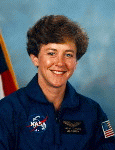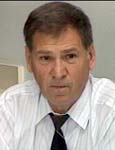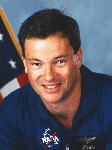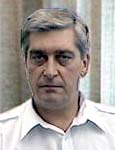
Shuttle-Mir Team Members (L - N)
Go
to
![]() Team
Members
Team
Members![]() Group (A -B)
Group (A -B)
Go
to
![]() Team
Members
Team
Members![]() Group (C - D)
Group (C - D)
Go
to
![]() Team
Members
Team
Members![]() Group (E - G)
Group (E - G)
Go
to
![]() Team
Members
Team
Members![]() Group (H - K)
Group (H - K)
 Wendy
B. Lawrence Profile
Wendy
B. Lawrence Profile
The first Shuttle-Mir flight for mission specialist Wendy Lawrence began on September 25, 1997, when the Space Shuttle Atlantis launched with the crew of STS-86 on the seventh shuttle flight to dock with Mir. This mission brought astronaut David Wolf to the station for his residency.
Lawrence was to have remained on the Mir herself, having trained for the increment from September 1996, until July 1997, at the Gagarin Cosmonaut Training Center in Star City, Russia. However, she was replaced by Wolf when conditions on the outpost made spacewalking on the Mir a requirement. Although cleared to serve on the Mir, Lawrence was not certified to conduct extravehicular activities because she was too small to fit into the Russian Orlan spacesuit.
The STS-86 crew returned to Earth on October 6, 1997, with astronaut Michael Foale, who had spent 4 ½ months on Mir.
Lawrence flew on a second Shuttle-Mir docking mission when the Space Shuttle Discovery lifted off on June 2, 1998. The ninth and last time the Shuttle linked with Mir, Lawrence and the crew of STS-91 returned to Earth on June 12, 1998, with Andrew Thomas, the last astronaut to have spent a residency on the station.
Regarding STS-91, Lawrence said she served "as the flight engineer during ascent entry, and then while we were docked, I was in charge of all the transfers, so you can imagine during the dock time frame, I was very busy making sure that we got our 6,000 pounds of logistics transferred between the two vehicles."
Lawrence also supported Phase 1 as a Director of Operations in Star City, Russia. As a DOR, she was responsible for the coordination and implementation of Phase 1 mission operation activities between Russia and NASA.
Lawrence became an astronaut in 1993. She earned a Bachelor of Science in ocean engineering from the U.S. Naval Academy and a Master of Science in ocean engineering from Massachusetts Institute of Technology and the Woods Hole Oceanographic Institution. She was designated as a naval aviator in July 1982, and has more than 1,500 hours flight time in six different types of helicopters and has made more than 800 shipboard landings.
![]()
Kathy Leary Profile
Kathy Leary was a Management Working Group member and the NASA representative responsible for coordinating the Phase 1 Joint Milestone Template. That template was used to generate a document that was prepared for each Shuttle-Mir flight, and it outlined the milestone events that NASA and Russia were responsible for delivering.
![]()
Oleg N. Lebedev Profile
Oleg Lebedev from RSC Energia served as co-chair for the Mission Science Working Group. This group developed Phase 1 scientific programs and experiments, and it defined the requirements for Shuttle-Mir science equipment.
Lebedev also served as the co-chair for the Mir Operations and Integration Working Group. That group coordinated the hardware integration, training, and operations activities of NASA hardware that flew on Russian vehicles.
Charles Stegemoeller, who was NASA's project manager for the Mir Spektr module, commented in his Oral History on the good relationship he shared with Lebedev: "I remember when the furloughs in the [American] government happened . . . we're in Mission Control Center here in Houston and we're calling up Oleg Lebedev, who was the team lead for the Russian side that we interfaced with. He commented back to us, he said, 'So I've never talked to an unemployed American before!' That humor was there on both sides. . .
"But it was knowing that we had enough history with each other that we weren't going to hurt each other in the process. We knew we could work together."
![]()
 Anatoli
Lomanov Profile
Anatoli
Lomanov Profile
Anatoli Lomanov was a Management Working Group member and the RSC Energia representative responsible for coordinating the Phase 1 Joint Milestone Template. That template was used to generate a document that was prepared for each Shuttle-Mir flight and outlined the milestone events that NASA and Russia were responsible for delivering.
Lomanov commented in his Oral History that he enjoyed working with his "American colleagues. We have a complete understanding. The issues which were difficult to resolve, we always were able to find a resolution to. So without being immodest, I have to say that we have a complete understanding and a wonderful working relationship. That is the beginning."
![]()
Dan Jacobs Profile
Dan Jacobs was the NASA Chairman of Institutional Communications working group.
![]()
 Michael
E. Lopez-Alegria Profile
Michael
E. Lopez-Alegria Profile
Michael Lopez-Alegria, a NASA astronaut, served as a Director of Operations (DOR) in Russia during Phase 1. As a DOR, he was responsible for the coordination and implementation of Phase 1 mission operations activities between Russia and NASA, managing a vital support systems office in Star City.
In his Oral History, Lopez-Alegria commented on his support team and related team members in Russia during his assignment as DOR:
"We had about three office clerical translator people who were sort of both -- all three were bilingual and served sort of the clerical functions. We had four (van) drivers. All those people are Russians, by the way.
"In addition to that, we had anywhere from one to three people serving as, I guess I'd call it, a payload training/baseline data collection organizer who was responsible for scheduling the training for both the Americans and Russians on the Mir for the American payloads experiments, basically, most of which were biomedical experiments.
"And then we had a flight surgeon, always, at least one, whenever there was a crew member there. Finally, the crew themselves, which depended on-you know, people would show up, ideally 14 months before they flew, and then they'd spend some time as a back-up, training then sometime as a prime, and then they'd go and fly. So you would sort of see this overlapping scenario of people coming and then going, and then somebody else would come."
Lopez-Alegria became an astronaut in 1992 and flew on STS-73 as a mission specialist. Prior to his NASA career, he was a naval aviator in the United States Navy. He has a Bachelor of Science degree in systems engineering from the U.S. Naval Academy and a Master of Science degree in aeronautical engineering from the U.S. Naval Postgraduate School.
![]()
Thomas H. Marshburn Profile
Tom Marshburn was a NASA co-chair for the Medical Operations Working Group. This group was responsible for defining health care systems requirements in support of astronauts and cosmonauts involved in cooperative missions. He was also the NASA flight surgeon for the NASA 4, Linenger Increment.
As a flight surgeon, he accompanied Linenger to his training in Star City, Russia, where he was available to provide necessary medical care. He also acted as an occupational safety officer during Jerry Linenger's training. Additionally, Marshburn was on console in the TsUp (Russian mission control center) during Linenger's stay on Mir. He was essential in providing information directly to Linenger. In his Oral History, Marshburn spoke about the challenges encountered while trying to communicate with the U.S. astronaut while he was on the Russian space station:
"Jerry's [Linenger] mission was unique in that the comm became so bad; there was very limited time that we could talk as events unfurled in NASA 4, and the antenna for the satellite went out due to some heat and cooling problems. So we had very limited comm, it was often very ratty, and Jerry suggested and we went ahead and tried to do all of our communication by email using the packet system.
"So we had no voice communication with him for quite a while, for about two months. We'd hear his voice coming down on the Russian loop, and we would have a chance to say a few words to him, but the standard comm, for about two months, we didn't have. I think that was very unique."
Prior to his NASA career, Marshburn was an emergency services physician in Seattle.
![]()
 Isaac
W. "Caasi" Moore Profile
Isaac
W. "Caasi" Moore Profile
Caasi Moore was NASA's Operations Lead (Ops Lead) in Russia for the Blaha Increment. Duties included coordinating the communications between U.S.-Mir astronaut John Blaha, NASA, and Russia from the TsUP, the Russian Mission Control Center.
As the Ops Lead, he was in charge of the Mir Operations Support Team for Increment 3, managing a group that included a long-duration science coordinator, a payload engineer who was responsible for the operations of the American science hardware on Mir, a biomedical engineer, a flight surgeon, a public affairs representative, and a crew interface person. Caasi Moore was also a technical manager in the Phase 1 Program Office, where he was responsible for the spacecraft operations involved in long-duration spaceflight. His expertise in that capacity centered on spacecraft operations, the operation of Mir, and the operations of Phase 1 science.
He also worked in NASA's training division for approximately 15 years, as well as in NASA's Mission Control Center at the Johnson Space Center, Houston, Texas. Additionally for STS-71 and STS-74, he served as a "groundhog" - a person who assisted the Russian engineers and flight controller representatives from Moscow who were in Houston to support those missions.
In his Oral History, Moore described a humorous incident that occurred in the Russian Mission Control Center while he was an Ops Lead that reminded him of the differences in the two cultures:
"I was down on console on comm, getting ready for the next pass for the crew members. In the control center they use one of their communications loops, and they just play music on it, background . So I'm sitting back here, and I'm hearing 'La Macarena' play, the music, just over the headset, and I'm hearing it kind of from speakers, and headsets that have been set down so it's kind of coming from the room.
"Then I realize that what I'm hearing is not coming from the voice loop. I mean, the music's there, but some of it's not, and I'm trying to figure out what's going on here. It's a little bit like the twilight zone. I look around, and I look over the console, and most of controllers in the room are doing the Macarena.
"I didn't have a camera, and I didn't have a camcorder, and I just calmly stood up and looked over, and it was all I could do not to fall out of my chair, because they were singing the Macarena and were doing the Macarena in the control room for Mir.
"Now, I was trying to imagine that over here in the control center in Houston, and I can't. That's just not a vision that I can do. But here are these people working, they've been working hard, they've worked for months, they've worked for years in here; the Macarena is played, and so they're going along with it, sitting on console. And, you know, you just sit back and go, 'There are different things between the cultures.' And I tried not to make an international incident by falling out of my chair."
![]()
 Patricia
"Patti" Moore Profile
Patricia
"Patti" Moore Profile
Patti Moore was NASA's Operations Lead (Ops Lead) in Russia during the Wolf Increment. Her duties included coordinating communications between Mir astronaut David Wolf, NASA, and Russia from the Russian Mission Control Center.
As an Ops Lead, Moore was in charge of the Mir Operations Support Team in Moscow, where she managed a group that included a flight surgeon, a payload engineer to troubleshoot science equipment problems, a mission science representative, a systems engineer who kept Johnson Space Center officials informed about Mir hardware problems, a timeline engineer for scheduling purposes, a public affairs representative, and a biomedical engineer.
Ops Leads such as Moore followed crewmembers through training at NASA and at Star City, Russia, enabling a good rapport with the crewmembers and a solid knowledge of the experiments the Mir astronauts would be performing on-orbit.
Prior to her Moscow assignment, Moore worked on Spacelab projects in the Payload Operations Control Center at the Marshall Space Flight Center in Huntsville, Alabama.
In her Oral History, Moore commented on the expectations she had concerning her duties in Russia: "I'm from Spacelab world, and when you're working a Spacelab mission, you come off console totally drained, mentally and emotionally, basically, because for 14 days you're just really running and going.
"When I started this I was going, 'I'm going to be bored. You only talk to the crew twice a day.' I mean, there's only contact with the crew 10 minutes per orbit. That's really amazing. I thought, 'Wow. There's too many people over there; we don't have enough to do. We're going to be sitting around a lot.' That was not the case at all.
"We were all busy every minute from the time you walked in the door until the time you left in the evening, and sometimes it would get a little overwhelming, but really the workload was steady. It was like piecing together a jigsaw puzzle sometimes."
![]()
 Valeri
V. Morgun Profile
Valeri
V. Morgun Profile
Valeri Morgun from the Gagarin Cosmonaut Training Center served as a co-chair for the Medical Operations Working Group. This group was responsible for defining health care systems requirements in support of astronauts and cosmonauts involved in cooperative missions.
Morgun worked very closely with his American counterpart, Roger Billica of the NASA Johnson Space Center during Phase 1. Together, they chaired the working group on medical support. In his Oral History, Morgun said:
"Our group had levied upon it a number of very responsible problems, issues, to solve; for example, medical support and preparation of both cosmonauts and astronauts, the medical support in the course of space flight, and support in the post-flight period. Our group developed and compared joint medical standards. We concurred in a medical monitoring system. We concurred in questions related to practical medical issues, and we concurred in questions regarding the preparation of medical experiments to be carried out . . .
He added, "Today, we're no longer Drs. Billica and Morgun; we're friends. This whole period has taught both him and me that this is the way to work. I'm very happy that both U.S. and Russian medical teams are moving on into Phase 2. I know that this will make our work in Phase 2 easier. It will make it more simple, because we already know each other, we know each other's styles of work, we're aware of some of the difficulties that are in front of us and how to eliminate those difficulties. So it's a very positive outlook for such cooperation in Phase 2."
![]()
Mike Mott Profile
Mike Mott served as NASA's Associate Deputy Administrator from December 1993 to June 1998. In this role, he reported directly to the NASA Administrator and provided management, direction, technical coordination and implementation of NASA programs. He also developed and implemented policy and procedures for the Administrator and assisted in executing space flight programs and operations.
Involved with NASA during Phase 1, Mott said the following about the success of Shuttle-Mir Program.
"I think with Phase 1 we've shown that we can work with international partners. If you look at the [International] Space Station that's on orbit right now [as of 4/23/99], you have two pieces of flight hardware that were never within 10,000 miles of each other, flown in space, rendezvoused, docked, and the light switch was turned on and everything worked. That is an incredible engineering achievement. Not ever have we done that before in the space program."
Prior to his NASA career, Mott served on the redesign team for the International Space Station. Also, Mott served in the US Marine Corps in numerous operational and staff assignments throughout the United States and the Western Pacific. He is a graduate from the US Naval Test Pilot School, participating in 89 major flight test projects, and commanded Marine Aircraft Group Forty One at Andrews Air Force Base.
![]()
James R. "Jim" Nise Profile
Jim Nise was NASA's contract director for the Shuttle-Mir Management Working Group. Within this group, Nise helped to establish configuration management control standards, as well as the standards for Phase 1 documents and communications.
In his Oral History, Nise spoke of one of the many lessons learned during the program:
" . . . this program has taught me that you need to consider the other side's point of view up front or you're going to waste your time. We are culturally significantly different. We're growing closer toward each other, but we're culturally significantly different, and when you have brought something up and they don't necessarily jump at it with glee, you need to go back and reconsider why that is and figure out how to move things along. It makes for an interesting day."
![]()
 Donald
S. Noah Profile
Donald
S. Noah Profile
Don Noah was the lead in charge of all shuttle integration for STS-74, including the Shuttle-Mir docking module that would reside on Mir for future shuttles dockings. In his Oral History, he described the challenges of the docking module:
"From the element itself, it's fairly simple. I mean, it's a big tube that's pressurized. It has a fairly complex mechanism on each end. The challenge on this was not so much the complexity. I mean, NASA's flown payloads or integrated payloads that had more complex interfaces with the orbiter and interplay with the orbiter than this did.
"The challenge on this was doing it in no more than a short period of time. Even if it had been an American company, no matter how simple it was, doing something that large, and it was complex, it had a lot of interfaces, in the short time frame is a big challenge. But then doing it with another country with a totally different language and a totally different culture in how they design and build hardware was the biggest challenge. . . A lot of people worked real hard to overcome those obstacles to make the hardware work as well as it did."
After STS-74, Noah was responsible for the integration analysis for all payloads that were included on shuttle missions.
He was also the logistics manager on STS-71. As logistics manager, Noah was responsible for writing the hardware requirements and developing interface control documents for the Russian hardware flown on the shuttle to Mir for transfer, and for Mir hardware then returned on the shuttle.
![]()
 Richard
W. "Rick" Nygren Profile
Richard
W. "Rick" Nygren Profile
Rick Nygren from the NASA Johnson Space Center was the co-chair for the Mir Operations and Integration Working Group (MOIWG) and was the Space and Life Sciences Directorate Assistant Director for Russian Programs.
The MOIWG was responsible for the long duration aspects of the Phase 1 Program, coordinating the hardware integration, training, and operations activities of NASA hardware that flew on Russian vehicles. Nygren was responsible for accomplishing the goals of this group.
To meet the needs of the flight operations aspects, flight operations teams were located both in the TsUP (Russian Mission Control Center in Moscow) and the Mission Control Center in Houston, Texas, in support of the missions.
Regarding the crew training as it related to the operation of the US provided research hardware on the Mir, permanent teams conducted crew training at Star City, Russia, and in the US (two 3-week sessions) for each long duration mission.
To integrate all of the US research hardware on to the Mir Space Station, Nygren managed the efforts that designed and integrated a significant amount of hardware into the Spektr and Priroda modules preflight, as well as the integration of all of the US hardware that traveled on the Progress vehicles and the Shuttle for use during the long duration missions, and the integration of the US research hardware into the Shuttle middeck.
As Assistant Director for Russian Programs, his responsibilities included performing an oversight/management function as it related to the two other Phase 1 working groups that were within the Space and Life Sciences Directorate (the Mission Science Working Group and Medical Operations Working Group). He also chaired a configuration control board that was responsible for the approval of the U.S. science requirements, medical requirements, and the implementation of the U.S. research program being conducted on the Mir.
In his Oral History, Nygren commented that although differences were evident in Russian and American working practices, the two groups were able to accomplish a great deal together. The following is an example, referring to the hardware for the Spektr module:
"We would just sit down and talk ad infinitum with the Russians about, 'Where's the hole pattern for this? What is it we're supposed to match drill to?' They said, 'Well, just drill the holes and tell us where they're at.' And you know, that's just foreign to us. We couldn't believe it. 'Drill the holes and tell you where they're at? You're not going to build your spacecraft to our standards. You know, if we deliver this thing and we don't match up the holes, this isn't going to work.'
"Well, it turns out in a lot of cases that's exactly what they did. We ended up shipping our stuff over there, they checked it out functionally, loaded it up in a bunch of boxes, took it down to Baikonur, where the Spektr module was at. They would go in there, they would take our module in there, and they'd slap it up there, and they'd take a piece of chalk and they'd mark where the holes were, and they'd take ours out, and they'd drill the holes, and they would bolt it in right there.
"It sure cuts down on a lot of engineering drawings and stuff, but it was foreign to us, because we kept thinking we have to have all these interface drawings and agreements, and, they're, 'No, no, no. Just bring the hardware. We'll figure out a way to make it fit.'"
![]() Go
to Team Members group (A - B)
Go
to Team Members group (A - B)
![]() Go
to Team Members group (C - D)
Go
to Team Members group (C - D)
![]() Go
to Team Members group (E - G)
Go
to Team Members group (E - G)
![]() Go
to Team Members group (H - K)
Go
to Team Members group (H - K)